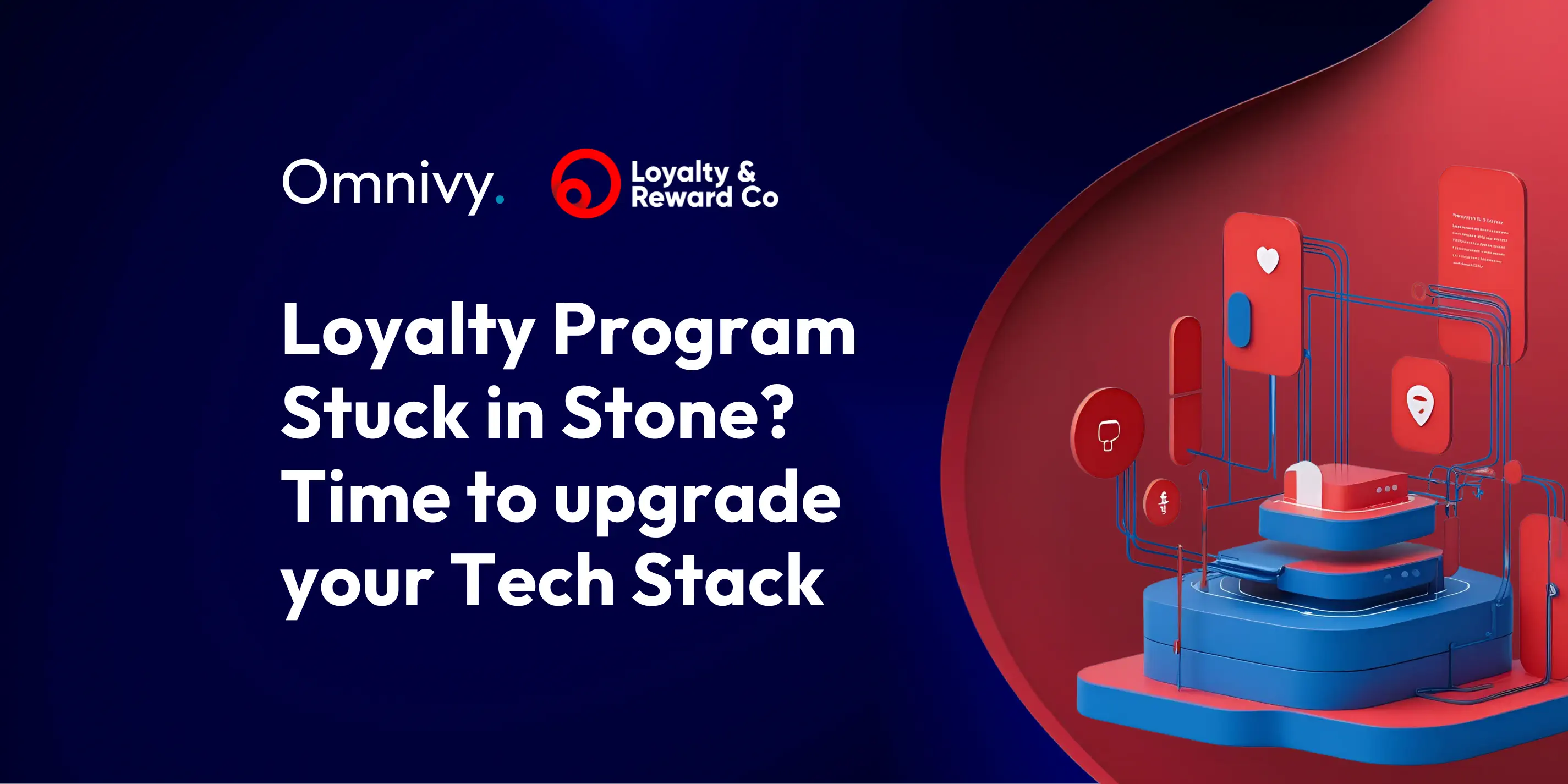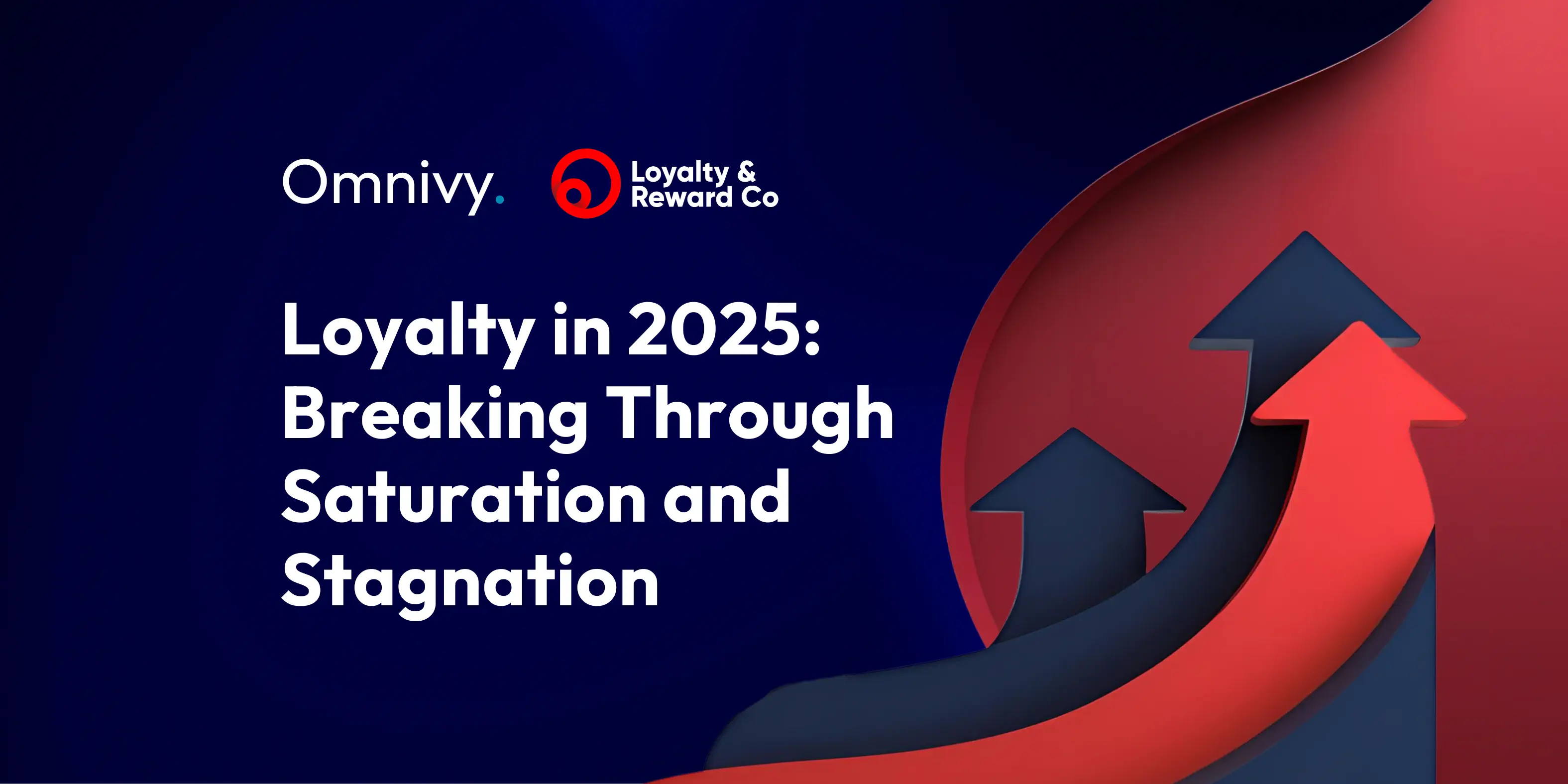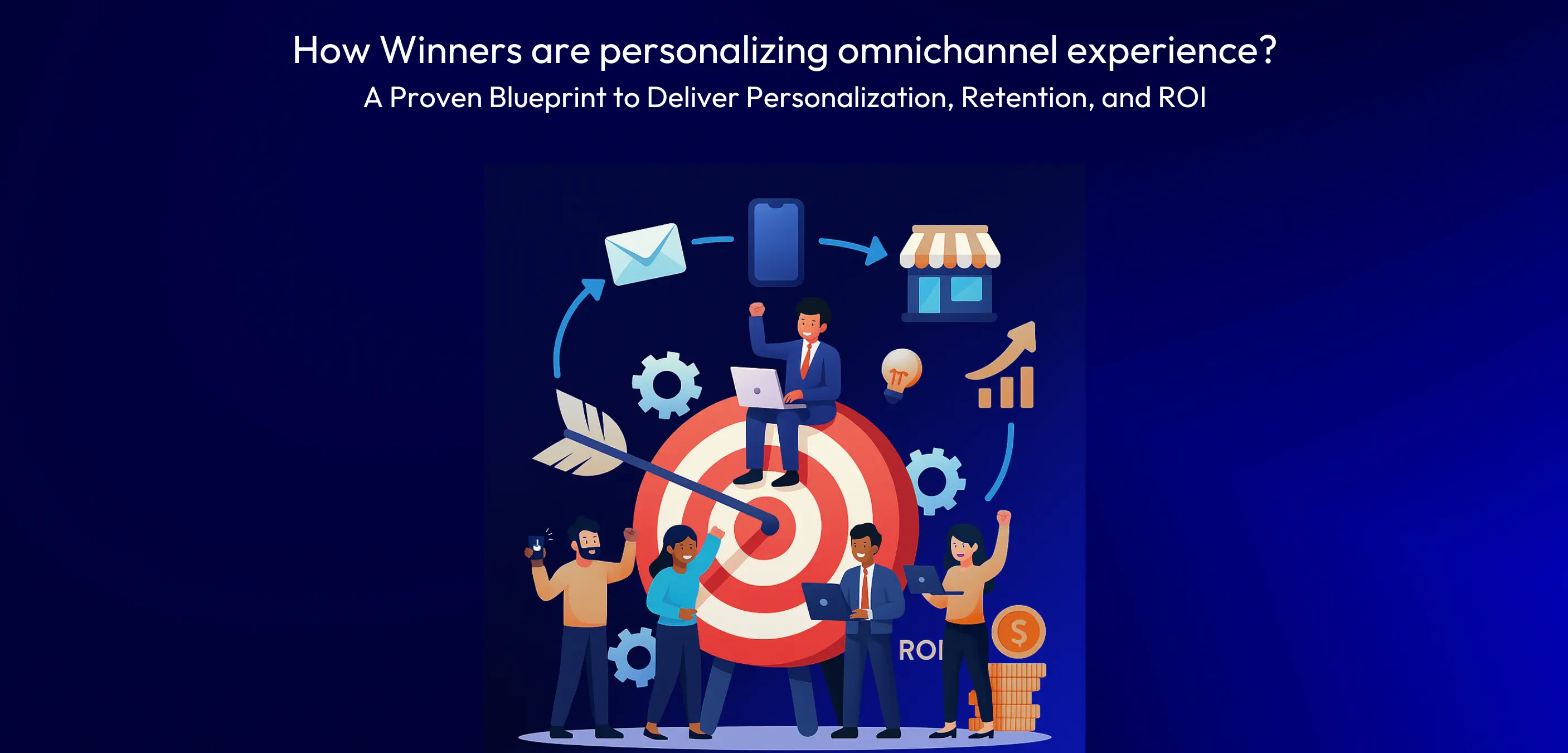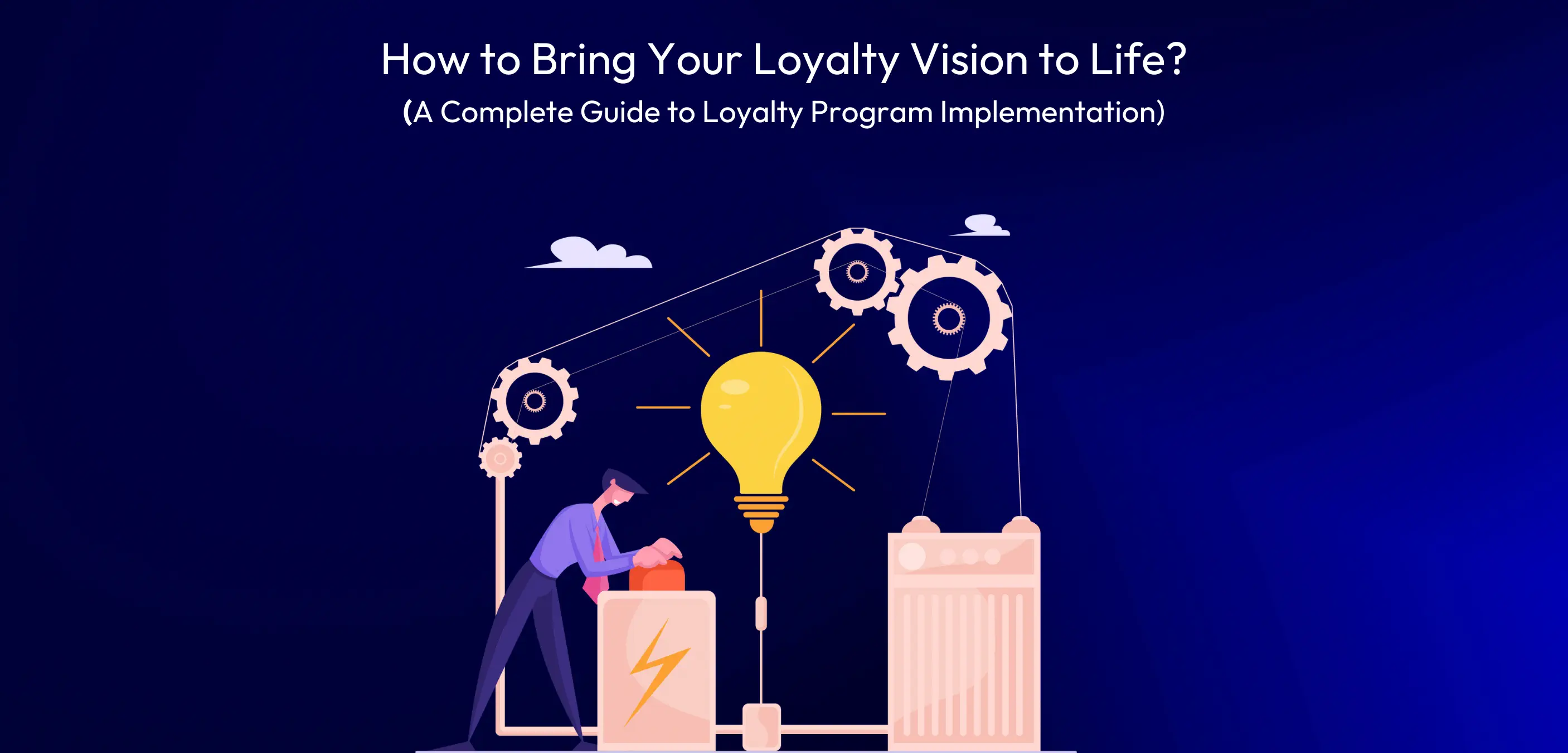The critical connection between execution speed, personalization, and composable loyalty architecture.
In our recent joint article with Loyalty & Reward Co, “Loyalty in 2025: Breaking Through Saturation and Stagnation" we laid out a roadmap for the evolution of modern loyalty programs. The message was clear: in a market crowded with points, discounts, and lookalike tier structures, competitive advantage will come not from doing more of the same, but from delivering experiences that feel personal, contextually relevant, and emotionally valuable.
However, while the strategic direction is widely accepted - simpler mechanics, richer personalization, and experience-led design - most loyalty and CRM leaders face a sobering challenge when attempting to bring that vision to life. The challenge isn’t a lack of ambition, creativity, or even budget. It’s the realization that their existing loyalty program architecture simply cannot support what the new loyalty landscape demands.
In practical terms, even modest changes to loyalty logic, such as introducing dynamic rewards or personalizing campaigns based on behavior, are frequently slowed down by legacy architecture. The result? Execution becomes the bottleneck. Campaigns are delayed. Personalization is superficial. Testing is risky. And loyalty strategies, however well-crafted, stall at the operational layer.
Meanwhile, we see a growing divide in the market. The brands that are advancing loyalty aren’t doing so by offering more points or deeper discounts. They’re the ones launching contextual offers, rewarding behaviors across touchpoints, and responding to customers in real time. They’re winning by orchestrating consistent, data-driven journeys across channels. Their competitive edge lies not in creativity alone, but in their ability to execute at speed and scale, because their composable MarTech architecture was designed to enable it.
This is the critical shift loyalty programs must confront in 2025 and beyond. In this article, we examine the specific technical and organizational blockers preventing loyalty programs from evolving. What you’ll learn:
- Why “all-in-one” loyalty platforms create blockers
- What composable loyalty is and what it isn’t
- How to build a modular stack, one use case at a time
- How to identify and remove the bottlenecks in your loyalty architecture
Why Loyalty Breaks at the Execution Layer
Let’s look at four structural problems that keep loyalty teams stuck.
1. Loyalty & Marketing live in a monolithic architecture
Marketing wants to experiment with new offers. CRM wants to launch a targeted win-back campaign for dormant members. The product team needs real-time data to personalize in-app experiences. Retail teams want to iterate quickly and test offers.
But every small change has to be routed through IT, and every change request means development, regression testing, and a slot in the next quarterly release cycle. This scenario leads to a cascade of operational and technical challenges typical of monolithic systems in retail. Here are the common symptoms:
- Innovation gets stuck - Ideally, your developers would be experimenting and releasing new features all the time. But in a monolith, every change is tangled with lots of dependencies. Teams have to coordinate, plan, and test everything together. Developers end up spending more time in meetings and coordination and less time building cool stuff. By the time something new goes live, it’s already old news.
- One problem, big trouble - Monolithic systems are fragile. If one part breaks, it can take down the whole site. For example, a bug in the loyalty module might crash your checkout, or worse, the entire store.
- Scaling is inefficient - When you expect more traffic, you have to scale up the entire system, even parts that aren’t busy. This wastes resources and money, and you end up paying for capacity you don’t really need.
- Locked into one stack - Tech evolves quickly, and so do customer expectations. But monolithic systems tie you to one set of tools and frameworks. Want to try a smart recommendation engine or a new loyalty feature? If your stack isn’t ready for it (and it probably isn’t), you’re looking at months of work just to make it fit. In a world where speed matters, that’s a big disadvantage.
In the end, the original campaign idea - a quick, creative incentive - takes six weeks, five people, and a dozen meetings. And that’s if nothing goes wrong.
2. Campaign logic is fragmented across systems
Loyalty program logic (who qualifies, what triggers, where it's shown) is often scattered across uncoordinated platforms like e-commerce, POS, ERP, and marketing automation tools. This fragmentation leads to inconsistencies, customer confusion (different offers across channels), and operational inefficiencies. Campaigns require manual replication of rules across systems, and cross-channel functionality (e.g., in-store coupons usable online) is often lacking.
3. Personalization is limited by disconnected data
The dream of "right offer, right time, right channel" is limited by a lack of a unified customer view. CDPs may hold data, but loyalty engines don't ingest it in real-time. Segments defined in analytics can't be actioned in campaigns. This forces loyalty teams to simplify personalization, resorting to broad segments like "all gold-tier members" instead of granular, behavior-driven triggers.
4. Loyalty is Buried in the Wrong Systems
Many brands run loyalty programs within ERP modules, legacy CRM extensions, or marketing platforms where loyalty is a mere plug-in. These systems weren't designed for real-time decisions, flexible reward logic, or omnichannel engagement. This severely limits experimentation (e.g., testing referral mechanics) because the underlying platform can't model or support it, keeping programs static.
Composable Loyalty in Action: What a Modern Customer Journey Looks Like
Meet Julia. She’s a high-value customer, shopping mostly in-store but browsing online weekly. She’s just visited the product page for a limited-edition running jacket three times in the past week, but hasn’t purchased yet. In most companies, this behavior goes unnoticed - or worse, it triggers a generic 10% off email that undercuts margin without adding real value.
But in a connected stack, the experience unfolds differently:
- The system recognizes the pattern: product interest + high intent, no purchase
- Inventory data shows only two jackets left in her size at her local store
- A real-time trigger sends her an in-app message: “Looks like you’re eyeing this. Want us to reserve one for you?”
- No discount. No friction. Just a timely, personal gesture that creates urgency
After purchase, she instantly unlocks early access to a new product line, followed by a personalized push notification for double points on matching items.
This thoughtful, relevant experience is driven by orchestration:
- A flexible loyalty engine recognizing Julia's behavior.
- Real-time data exchange between e-commerce, POS, inventory, and marketing
- A single, centralized profile driving both rules and communications
- Execution across touchpoints (in-app, in-store, push) triggered from one rule set
This isn’t magic. It’s architecture.
Redesigning Loyalty Architecture with a Composable Approach
What is Composable Loyalty?
Composable loyalty is an architectural approach where each system — loyalty engine, CDP, MA platform — does what it does best and connects via APIs. Composable MarTech lets you build a best-of-breed stack that is flexible, scalable, and fast to evolve. Forrester (2021) found that organizations with high composability maturity reduced time-to-market by 65%.
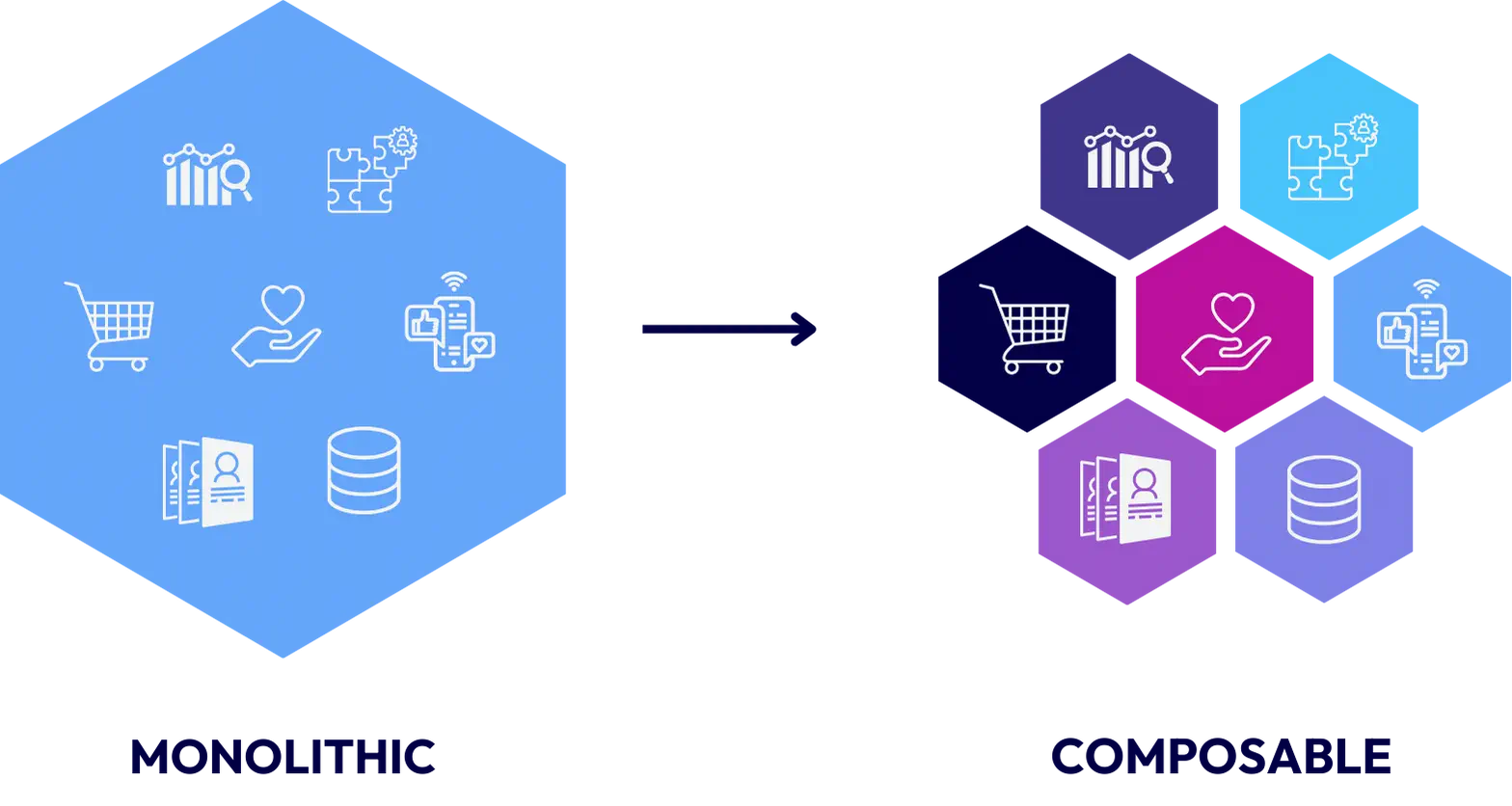
What Does Composable Loyalty Look Like? Each layer of the customer experience is handled by a dedicated, specialized component:
- Frontend Channels: apps, e-comm, cashier screens - all pulling from the same logic
- CRM: Platforms for managing customer interactions and data.
- Customer Data Platform (CDP): Unified customer profiles, segmentation etc.
- Personalization / Recommendation engines: Services for delivering recommendations and personalized customer experiences.
- Marketing Automation (MA): tools manage communication with customers and track their engagement
- Loyalty Engine: Rules, tiers, expiry, benefits
The power of composability is choice: building a stack based on specific business needs, not a one-size-fits-all solution. This allows for seamless scalability and integration.
"API-first, native connectors, and orchestration layers — this is the future of loyalty and engagement stacks"
Maciej Tyczynski, co-founder and CTO of Omnivy
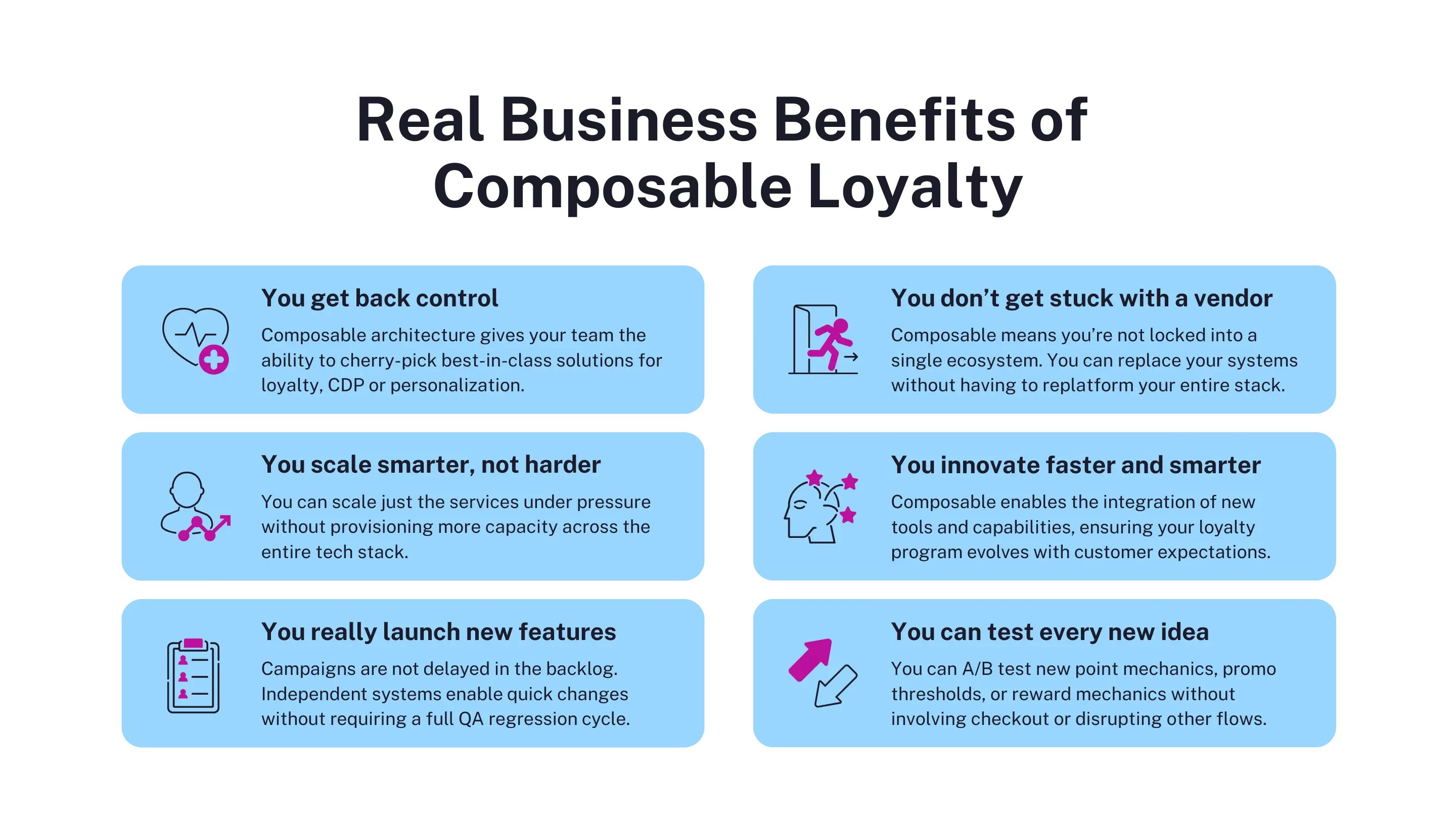
How to Move from Fragmented to Personalized Experiences (Step-by-Step)
You don't need to rebuild your stack entirely, but you must shift its structure and where logic lives:
Step 1: Centralize Your Loyalty and Promotion Logic
The first step is to stop spreading your incentivization rules across multiple systems. You need a dedicated engine that handles all incentive logic in one place: loyalty points, tier management, coupon issuance, discount rules, bundles, referrals, and more. This engine becomes the brain of your promotional strategy. Rather than duplicating rules across e-commerce, POS and app, every system calls Centralized Loyalty & Promo Engine to ask: “What should happen for this customer, right now, based on what they just did?”
This shift from static rule-setting to API-based orchestration is what unlocks flexibility. You can introduce new mechanics instantly, run A/B tests, or adjust campaign in real-time, without rewriting logic in five systems manually.
Step 2: Add a Real-Time Data Layer
Your promotion engine needs real-time data to personalize incentives and automate triggers. A CDP or data warehouse acts as the intelligence layer, continuously updating customer attributes and behavior, enabling smart campaigns. A standard loyalty program might give 100 points for any purchase above $100. A composable one can give:
- Lower discount for Clients with higher propensity score / full-price buyers
- Free shipping for gold-tier customers usually buying in-store
- A bonus for first-time buyers who haven’t used a promo code
It’s the same engine - just powered by data.
Step 3: Sync All Execution Channels
Next, you connect your front- and back-end systems to the promotion engine. These systems - whether it’s e-commerce, POS, marketing automation, CMS or your mobile app - are no longer responsible for calculating what to give or show. They simply execute based on responses from Loyalty & Promo Engine. For example:
- Marketing automation pulls real-time point balances or tier upgrades into emails.
- POS queries the engine during checkout to validate and redeem a coupon.
- E-commerce applies cart-level discounts based on current customer status.
No more manual syncs. No more mismatched offers. One rule, executed everywhere - instantly.
Step 4: Launch a High-Impact Pilot
Start with a focused use case, such as a high-margin category or a top-tier segment. Configure the logic in your central engine, pull segments from your CDP, deliver messages via MA, and handle redemption across relevant channels. This allows for rapid testing of orchestrated, multi-channel campaigns.
Step 5: Don’t Build It Alone
While composable architecture requires careful design, you don't need to reinvent the wheel. Look for proven tools and partners like Omnivy’s Integration Accelerator which offer pre-integrated connectors and frameworks, enabling you to go live in weeks, not months, with real-time data and omnichannel execution.
Real-World Results: A Composable Stack in Action.
Case Study: BioTechUSA
BioTechUSA is a leading European brand in dietary supplements, with 2,000+ products, 328 stores, and a rapidly growing digital presence. Known for its bold, performance-driven positioning - including a partnership with FC Barcelona - the brand aimed to deepen customer relationships by building a modern, omnichannel loyalty program.
The Problem: Building Loyalty Without a Loyalty Engine
For years, BioTechUSA tried to deliver personalized loyalty experiences using a combination of a well-known all-in-one ERP and marketing automation. They turned out to be a patchwork - a mix of poorly connected acquired solutions that couldn’t scale.
There was no real loyalty engine. Rules were basic, personalization was blocked, and promotions had to be manually replicated across systems. Campaigns stalled. Opportunities were lost.
The Breakthrough: A Composable Loyalty Stack
To turn loyalty from a bottleneck into a growth driver, BioTechUSA selected a new architecture:
- Klaviyo became the master hub for customer data and communication. Segmentation, RFM scoring, and behavioral triggers all run here.
- Talon.One was introduced as the central engine for all incentives, powering both loyalty mechanics and broader promotional logic. It connects directly to both Shopify Plus and a custom POS, ensuring that rules execute consistently across online and in-store journeys.
- All the systems exchange the data through Omnivy’s Integration Accelerator: Talon.One receives customer context data from Klaviyo and transactional data from POS and Shopify, determines the right reward or offer, and triggers messaging and redemption flows in real time.
- The stack is now designed for future evolution - ready to plug into AI recommendation engines or new communication channels as the strategy evolves.
The Execution
Omnivy led the end-to-end delivery across 7 markets, 328 stores, and over 1.2 million members - integrating all systems, orchestrating the data flows, and managing a smooth switchover from the legacy setup. Loyalty campaigns now run across channels with real-time syncing, dynamic reward logic, and zero friction between tech layers.
“We didn’t just replace a tool. We rebuilt our capabilities with partners who understood what growth truly demands. Today, the system runs like a well-orchestrated stack - reliable, scalable, and perfectly in sync.”
Daniel Petri, Head of E-commerce, BioTechUSA
The Outcome: BioTechUSA now operates a unified, scalable tech solution built for speed. Promotions are consistent, offers are personalized and timely, and loyalty is a dynamic part of the customer experience.
Conclusion: How to Evolve Loyalty Programs – Strategically and Technically
The boldest loyalty programs aren’t always the flashiest. They’re the ones that work: fast, relevant, seamless. If your loyalty program architecture is monolithic or stitched together with workarounds, no strategy will scale.
In 2025 and beyond, loyalty innovation will be defined by how fast you can bring ideas to life. The most impactful loyalty programs are those that work seamlessly, intelligently, and across every customer touchpoint. Personalization, agility, and orchestration are no longer "nice to haves" – they are foundational to staying relevant. This is impossible if campaign logic is buried in monolithic systems or fragmented across disconnected tools.
Composable architecture changes the game by offering a practical answer to execution problems. When your stack is well-designed:
- You personalize incentives in real time, with seamless data flow.
- You launch, test, and optimize campaigns in days - not quarters.
- You centralize your loyalty and promotion logic, so every channel tells the same story.
- You stop firefighting integration issues and start designing better customer experiences.
This article was co-created by Omnivy and Loyalty & Reward Co
Omnivy is a loyalty system integrator that accelerates innovation using composable MarTech stacks. Loyalty & Reward Co is a global consultancy specializing in loyalty strategy, program design, and performance optimization.
Together, we help brands move from strategy to execution, with the loyalty system design and technical firepower to deliver measurable results.
